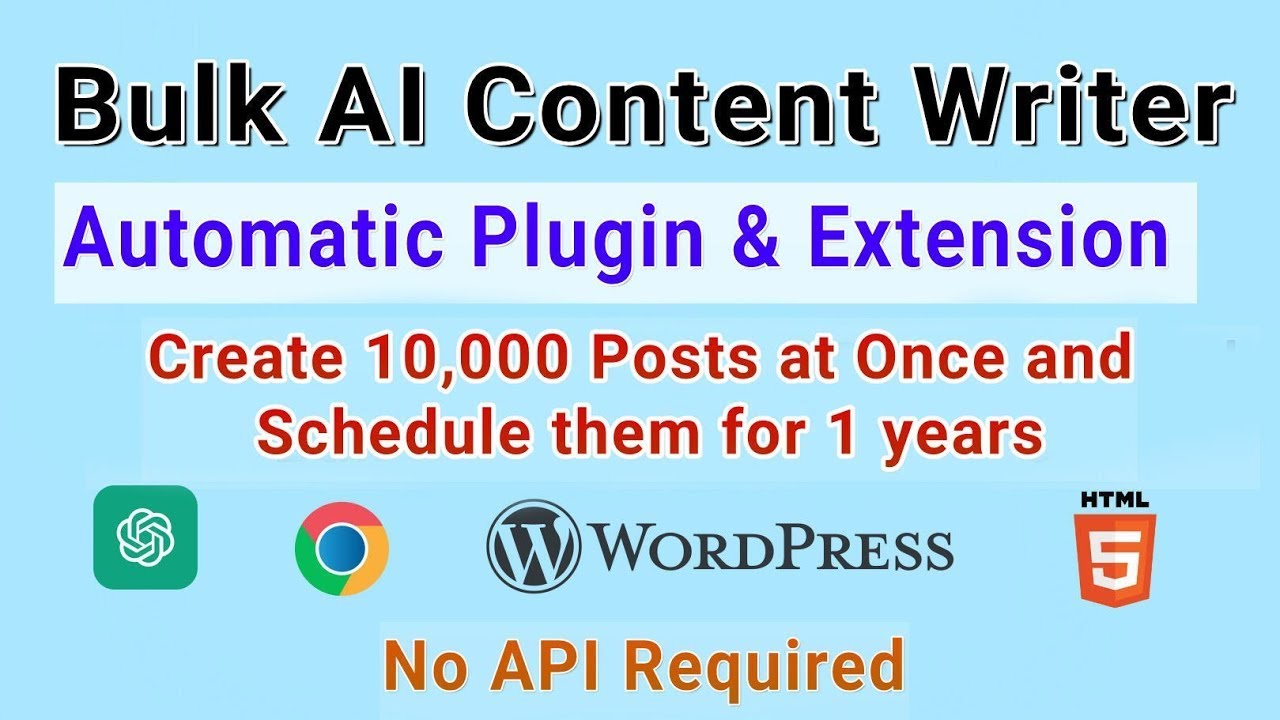Blog
Create Bulk Content for WordPress with ChatGPT and Schedule Posts for 1 Year

Mastering Bulk Content Creation for WordPress with ChatGPT and Year-Round Scheduling
Consistently publishing high-quality content is essential for building authority, driving traffic, and boosting SEO for any WordPress website. However, maintaining a steady stream of posts can become overwhelming. The solution? Combining ChatGPT’s AI content generation capabilities with WordPress scheduling tools to publish months—or even a year—of content in advance. This guide walks you through creating, optimizing, and automating your content pipeline efficiently.
Why Bulk Content Creation Matters
Producing content in bulk offers three key advantages:
- Time Efficiency: Designing a content calendar upfront reduces daily decision fatigue, letting you focus on strategy and growth.
- Consistency: Regular posting improves SEO rankings and user engagement.
- Scalability: Bulk workflows allow you to plan campaigns, seasonal content, or product launches without last-minute stress.
Step 1: Strategize Your Content Calendar
Before generating content, outline a clear plan to ensure relevance and alignment with your goals.
Identify Core Themes and Keywords
Start by researching topics relevant to your audience. Use tools like Google Keyword Planner, SEMrush, or Ahrefs to identify:
- High-traffic, low-competition keywords
- Trending topics in your niche
- Evergreen subjects that remain relevant over time
Pro Tip: Create pillar content around broad themes (e.g., “Beginner’s Guide to Digital Marketing”) and subtopics (e.g., “Email Marketing Tips for Startups”) for better organization.
Map Out a 12-Month Timeline
Categorize your content by:
- Seasonal Trends (e.g., holiday gift guides, summer fitness routines)
- Product Launches or Promotions
- Evergreen Tutorials or How-To Guides
- Industry News or Updates
A visual calendar (Google Sheets or Trello) helps track deadlines and balance topics.
Step 2: Generate Content at Scale with ChatGPT
ChatGPT accelerates content creation by drafting blog posts, meta descriptions, and FAQs in minutes. Follow these best practices to ensure quality:
Craft Detailed Prompts
Provide clear, specific instructions to get accurate outputs. For example:
“Write a 1,200-word beginner’s guide to container gardening. Include sections on soil preparation, plant selection, watering schedules, and pest control. Use a friendly, conversational tone.”
Batch-Create Drafts
Generate multiple variations of headlines, introductions, and outlines in one session. For instance:
- Ask ChatGPT to outline 10 blog post ideas about “Sustainable Living.”
- Use the best ideas to request full drafts.
Refine for Authenticity
While ChatGPT speeds up writing, human editing is crucial to:
- Eliminate robotic phrasing
- Add personal anecdotes or case studies
- Ensure factual accuracy
Step 3: Optimize Content for SEO
AI-generated content often requires tweaking to maximize search engine visibility.
Keyword Integration
Incorporate primary and secondary keywords naturally:
- Place the main keyword in the title, first paragraph, and subheadings.
- Use variations (LSI keywords) to avoid over-optimization.
Enhance Readability
- Break long paragraphs into 2–3 sentences.
- Use bullet points, numbered lists, and bold text to highlight key points.
- Aim for a Flesch Reading Ease score above 60.
Add Metadata
Craft compelling meta titles and descriptions that include keywords. Tools like Yoast SEO or RankMath provide real-time feedback to improve rankings.
Step 4: Schedule Posts Automatically in WordPress
WordPress offers built-in scheduling, but plugins streamline bulk management.
Native WordPress Scheduling
- Set a publication date under the “Post” settings.
- Click “Schedule” to queue the post.
Limitation: Manually scheduling hundreds of posts is time-consuming.
Advanced Plugins for Bulk Scheduling
- WP Scheduled Posts: Schedule posts in batches, view them on a calendar, and automate social media sharing.
- Editorial Calendar: Drag-and-Drop interface to reschedule posts effortlessly.
- PublishPress Calendar: Track team contributions and deadlines.
Step-by-Step Workflow:
- Upload all posts as drafts.
- Assign dates using a plugin’s calendar view.
- Set recurring posts for series or roundups.
Step 5: Maintain Quality Over Time
Pre-scheduled content requires periodic reviews to stay relevant.
Conduct Quarterly Audits
- Update statistics, broken links, or outdated examples.
- Refresh older posts with new keywords or sections.
Balance Evergreen and Timely Content
Avoid overloading your calendar with trend-based posts. A 70:30 ratio of evergreen to seasonal content ensures sustained traffic.
Monitor Performance
Use Google Analytics to identify:
- High-performing posts to expand into series.
- Low-traffic content needing SEO improvements.
Avoiding Common Pitfalls
Over-Automation
While AI tools save time, excessive automation can lead to generic content. Always add a human touch—share personal experiences or opinions to build trust.
Ignoring Analytics
Don’t “set and forget.” Track engagement metrics to refine your strategy.
Keyword Stuffing
Prioritize readability over keyword density. Search engines penalize unnatural phrasing.
Final Thoughts
Automating content creation and scheduling with ChatGPT and WordPress transforms how businesses approach content marketing. By batch-producing SEO-friendly articles and strategically planning their release, you can maintain a competitive edge with minimal daily effort.
Remember: The goal isn’t just to fill your calendar but to deliver consistent value that resonates with your audience. Regularly update your strategy based on performance data and evolving trends to keep your WordPress site fresh, relevant, and authoritative.
This approach empowers marketers, bloggers, and small businesses to scale their online presence efficiently—freeing up time for creativity, audience engagement, and growth-focused initiatives.

